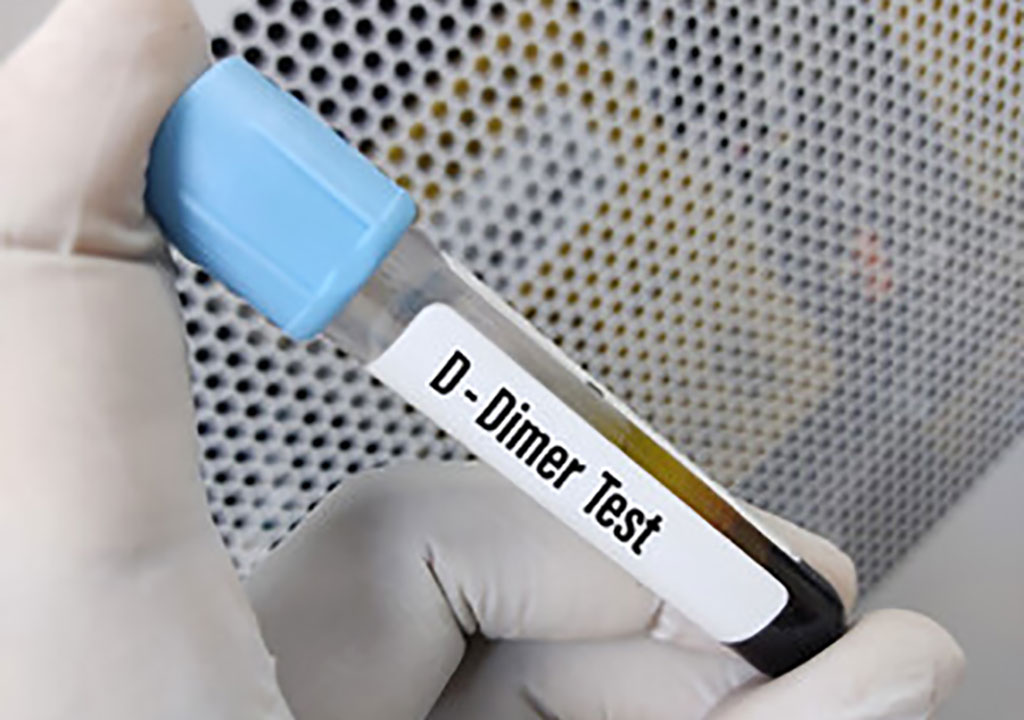D-Dimer Test Can Still Help Rule Out Pulmonary Embolisms in Hospitalized COVID-19 Patients
Posted on 27 Oct 2021
The D-dimer test can still be helpful in ruling out pulmonary embolisms in hospitalized COVID-19 patients, according to a new study.
Researchers at the University of South Florida Health Morsani College of Medicine (USF Health; Tampa, FL, USA) conducted a single-center, diagnostic study to investigate how well D-dimer testing performed at excluding pulmonary embolism in patients hospitalized with COVID-19. They found that the screening blood test originally validated in seriously ill patients without COVID-19 is still clinically useful for ruling out pulmonary embolism in patients hospitalized with the coronavirus.

Pulmonary embolisms occur when blood clots that form in another part of the body (often the leg), travel through the bloodstream, and lodge in the blood vessels of the lung, decreasing blood flow and causing low oxygen levels. Research indicates COVID-19 patients are three to 10 times more likely to develop pulmonary embolisms than other hospitalized patients, even when they are not as seriously ill or immobilized. Scientists are still investigating why, but it appears the COVID-19 virus may create a cellular environment that promotes clotting by making the inside of blood vessels uneven, irritated, and prone to microtears.
Doctors who suspect pulmonary embolisms routinely rely on widely available D-dimer screening to rule out the potentially life-threatening blood clotting disorder – most commonly in surgical patients immobilized for long periods and patients admitted to intensive care units. D-dimer is a simple blood test that measures protein fragments of blood clots floating in the bloodstream. D-dimer levels, normally undetectable or detectable at very low levels, rise sharply when the body is breaking down the clots. A negative D-dimer test (one that rules out pulmonary embolism) can help patients avoid more expensive, invasive diagnostic tests, like a computed tomography pulmonary angiogram, or CTPA.
The USF Health researchers wondered if the increased risk for blood clotting in COVID-19 patients, and uncertainty of diverse D-dimer values found in earlier smaller studies, reduced the existing screening tool’s ability to correctly rule out pulmonary embolism in COVID patients. The conventional thinking was that D-dimer levels would almost always be high in COVID-19 patients, therefore the test as originally validated (in non-COVID patients) would not be accurate at differentiating COVID patients without clots.
The restrospective study looked at the records of 1,541 patients hospitalized with COVID-19 at Tampa General Hospital from Jan. 1, 2020, to Feb. 5, 2021. They compared plasma D-dimer concentrations with CTPA, the criterion for diagnosing pulmonary embolism, in 287 of those patients. All COVID-19 patients with CTPA evidence of pulmonary embolism had D-dimer levels of 0.05 μg/mL or greater, as did the majority (91.2%) of patients without CTPA evidence of pulmonary embolism. (Concentrations of 0.05 μg/mL and higher are considered positive for pulmonary embolism, while anything below that D-dimer level is negative). The researchers also analyzed whether changing the cutoff levels defining positive or negative D-dimer test results specifically for the COVID patient population might improve the test’s performance.
Within the limitations of this single-center study, setting higher D-dimer thresholds was associated with improved specificity – but at “the cost of an increased false-negative rate that could be associated with an unacceptable patient safety risk,” the study authors wrote. A false-negative result means that the test does not detect a pulmonary embolism when the serious blood clotting problem is very likely present. While clinicians must maintain heightened suspicion for pulmonary embolisms when evaluating symptoms in COVID-19 patients, the overall USF Health study results indicate that the currently available D-dimer test adequately screens for the likelihood of pulmonary embolism in hospitalized COVID patients.
“Our study found that clinicians can feel confident interpreting the D-dimer levels the same in COVID patients as they do in every other patient; we don’t need a special (different) value for COVID patients,” said principal investigator Asa Oxner, MD, associate professor and vice chair of USF Health Internal Medicine. “So, in hospitalized COVID patients, we can appropriately rule out a pulmonary embolism if d-dimer levels are low.”
“The mechanisms of developing pulmonary embolisms may differ for COVID patients, but the resulting physiology is the same for all patients. The little fragments of (undissolved) blood clots are still detectable with D-dimer,” said Oxner.
Related Links:
USF Health













